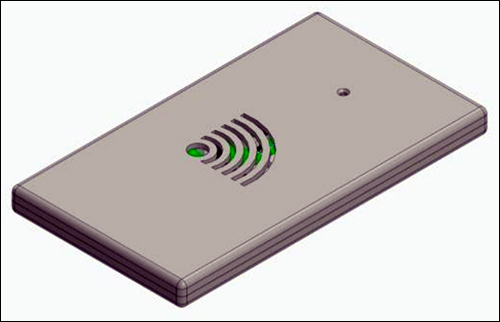Technology solutions that leverage radio frequency identification and sensors at affordable prices continue to evolve with a new passive RFID tag intended to accommodate multiple sensors and transmit data up to 32 feet using the power from the interrogator. Pennsylvania wireless power technology company Powercast‘s Multi-Sensor RFID tag (known as the PCT100) includes temperature, humidity and light sensors, while the company says future tags may also incorporate other sensors for monitoring such conditions as strain or motion.
The new tag was released earlier this month at the RFID Journal LIVE! conference and exhibition, held in Phoenix, Ariz. It requires no battery and is intended for capturing low-cost sensor data via RFID at the time that it is interrogated. It can incorporate one, two or all three sensors. It does not, however, have data-logger capacity. A user who wants to collect and store sensor data, even when the tag is not being interrogated, will need to use the PCT200 model with a built-in rechargeable battery for up to one month of data collection without recharging. The PCT200 can harvest energy from RFID interrogators to recharge the battery. The PCT200 also comes with up to three sensors.
However, the lower-cost option, despite being passive, is designed to be high-powered, the company reports, and can accomplish a read range of up to 10 meters (32.8 feet). “They efficiently harvest very small RF signals (down to -18dBm), allowing them to work [from] up to 10 meters,” says Charles Greene, Powercast’s COO and CTO. The tag uses an NXP Semiconductors UCODE chip and an RF to DC converter designed by Powercast to harness the energy from the RF signal for DC power.
The tag is designed for use in the industrial or manufacturing industries, to monitor the conditions around products or in an area during shipping or at a manufacturing site. Several businesses are already utilizing the technology to track environmental conditions, Greene reports, including building-automation companies, as well as manufacturing and logistic firms.
“We chose to make our own RFID tag based on customer input,” Greene says, to address shortcomings in existing technology. Several customers reported that the RFID sensor tags already on the market did not have a long enough read range or sensor accuracy, he explains, adding that the PCT100 and PCT200 can be interrogated via off-the-shelf UHF RFID readers, while some existing sensor tags require proprietary readers. One key benefit to the new tag, he says, is the low cost. Typically, the sensor tags cost between $10 and $35 apiece, depending on volume and whether or not they include a battery.
Because of the long read range, fewer readers may be required than are needed for other sensor tags. As an example, a Powercast RFID sensor tag may be placed within each box stacked on a pallet. The boxes in the center must be read through the other cartons and their contents, which can cause RF attenuation. “Our long read range and high sensitivity provide a much more robust solution,” Greene states. In the case of many of PowerCast’s customers, he adds, companies already have RFID readers in place to manage inventory or assets, so the existing reader infrastructure can work with the new tags.
The new sensor tags can come with an on-board LED to display the strength of the RF field as the tag is being interrogated. Both the PCT100 and the PCT200 are commercially available through Powercast’s distributors. Future sensors will be able to monitor vibration detection, tilt, stress and pressure, the company reports.
Electronic solutions company Matrix Product Development is offering the technology in its Wyze Temp batteryless temperature-monitoring system, for use in such applications as tracking conditions for perishable products loaded onto carts in the food industry. In that scenario, the tag sensor data can be captured automatically, in order to record the cooking and cooling temperatures of a cart, and thus of the product loaded onto that cart. This eliminates the need to interrupt the cooking process to measure temperatures.



